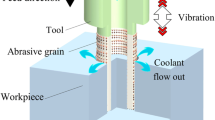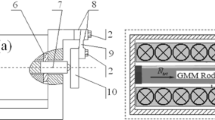Abstract
The giant magnetostrictive rotary ultrasonic processing system (GMUPS) with a loosely-coupled contactless power transfer (LCCPT) has emerged as a high-performance technique for the processing of hard and brittle materials, owing to its high power density. A capacitive compensation is required to achieve the highest energy efficiency of GMUPS to provide sufficient vibration amplitude when it works in the resonance state. In this study, an accurate model of the optimal compensation capacitance is derived from a new electromechanical equivalent circuit model of the GMUPS with LCCPT, which consists of an equivalent mechanical circuit and an electrical circuit. The phase lag angle between the mechanical and electrical circuits is established, taking into account the non-negligible loss in energy conversion of giant magnetostrictive material at ultrasonic frequency. The change of system impedance characteristics and the effectiveness of the system compensation method under load are analyzed. Both idle vibration experiments and machining tests are conducted to verify the developed model. The results show that the GMUPS with optimal compensation capacitance can achieve the maximum idle vibration amplitude and smallest cutting force. In addition, the effects of magnetic conductive material and driving voltages on the phase lag angle are also evaluated.
概要
目 的
具有松耦合非接触式电能传输装置 (LCCPT) 的超磁致伸缩旋转超声加工系统 (LCCPT) 可高效低损伤地加工硬脆材料. 为实现超声加工的最大效率, GMUPS需要在谐振状态下工作, 因此需要对系统进行电容补偿, 以实现更大的超声振幅.
创新点
1. 考虑系统机电耦合特性, 建立 GMUPS 的最佳电容补偿模型, 并在带载与不带载的情况下讨论模型的适用性; 2. 分析系统的相位滞后角的成因, 并探讨电压与材料特性对相位滞后角的影响.
方 法
1. 在考虑 GMUPS 机械等效回路和电回路之间的相位滞后角的情况下建立系统机电等效模型, 并加以推导, 从而获得空载最佳电容补偿模型. 2. 考虑负载的影响, 分析负载下系统阻抗特性的变化情况和系统的补偿方法. 3. 进行空载振幅测量实验和加工实验, 以验证理论模型的有效性.
结 论
1. 无论是在空载状态下还是在加工过程中, 采用最优补偿电容都表现出优越的性能. 采用最优补偿电容时, 系统可以获得最大振幅, 同时在整个加工过程中切削力最小. 2. LCCPT 的使用和补偿电容的取值对系统的电路特性有显著的影响, 而对机械谐振频率的影响很小. 电谐振频率更接近机械谐振频率可以提高系统的振动性能. 3. 系统电回路与机械等效回路之间的相位滞后角导致最小电流频率与机械谐振频率之间存在差异. 系统的相位滞后角与系统不必要的功率损耗直接相关. 在系统达到磁饱和前, 驱动电压对相位滞后角影响不大. 导磁结构的材料特性会显著地影响相位滞后角. 因此, 选择在高频处损耗低的导磁材料可以有效地降低相位滞后角.
Similar content being viewed by others
References
Cai WC, Zhang JF, Feng PF, et al., 2017a. A bilateral capacitance compensation method for giant magnetostriction ultrasonic processing system. The International Journal of Advanced Manufacturing Technology, 90(9):2925–2933. https://doi.org/10.1007/s00170-016-9602-4
Cai WC, Zhang JF, Yu DW, et al., 2017b. Research on the electromechanical conversion efficiency for giant magnetostrictive ultrasonic machining system. Journal of Mechanical Engineering, 53(19):52–58 (in Chinese). https://doi.org/10.3901/JME.2017.19.052
Calkins FT, 1997. Design, Analysis, and Modeling of Giant Magnetostrictuve Transducers. PhD Thesis, Iowa State University, Ames, USA.
Chen L, Zhu YC, Yang XL, et al., 2014. Driving magnetic path modeling and numerical analyses in giant magnetostrictive pump. China Mechanical Engineering, 25(6): 718–722 (in Chinese). https://doi.org/10.3969/j.issn.1004-132X.2014.06.002
Chen WY, 2015. Research on Underwater Acoustic Transducer Based on Giant Magnetostrictive Material. MS Thesis, Hangzhou Dianzi University, Hangzhou, China (in Chinese).
Claeyssen F, Lhermet N, Le Letty R, et al., 1997. Actuators, transducers and motors based on giant magnetostrictive materials. Journal of Alloys and Compounds, 258(1–2): 61–73. https://doi.org/10.1016/S0925-8388(97)00070-4
Fan P, Feng PF, Zhang JF, et al., 2019. Design and compensation of partially coupled contactless power transmission in GMM ultrasonic processing system. Aeronautical Manufacturing Technology, 62(5):88–95 (in Chinese). https://doi.org/10.16080/j.issn1671-833x.2019.05.088
Gong H, Fang FZ, Hu XT, 2010. Kinematic view of tool life in rotary ultrasonic side milling of hard and brittle materials. International Journal of Machine Tools and Manufacture, 50(3):303–307. https://doi.org/10.1016/j.ijmachtools.2009.12.006
Huang HY, Paramo D, 2011. Broadband electrical impedance matching for piezoelectric ultrasound transducers. IEEE Transactions on Ultrasonics, Ferroelectrics, and Frequency Control, 58(12):2699–2707. https://doi.org/10.1109/TUFFC.2011.2132
Jiang XG, Zhang DY, 2007. Matching theory of ultrasonic transducer at its passed inherent resonance zone. Journal of Mechanical Engineering, 43(3):182–186 (in Chinese). https://doi.org/10.3321/j.issn:0577-6686.2007.03.031
Liu DF, Cong WL, Pei ZJ, et al., 2012. A cutting force model for rotary ultrasonic machining of brittle materials. International Journal of Machine Tools and Manufacture, 52(1):77–84. https://doi.org/10.1016/j.ijmachtools.2011.09.006
Liu JJ, Jiang XG, Gao Z, et al., 2019. Investigation of the effect of vibration amplitude on the surface integrity in high-speed rotary ultrasonic elliptical machining for side milling of Ti-6Al-4V. Journal of Mechanical Engineering, 55(11):215–223 (in Chinese). https://doi.org/10.3901/JME.2019.11.215
Ma K, Wang JJ, Zhang JF, et al., 2022. A highly temperature-stable and complete-resonance rotary giant magnetostrictive ultrasonic system. International Journal of Mechanical Sciences, 214:106927. https://doi.org/10.1016/j.ijmecsci.2021.106927
Pang MX, 2010. The Design Theory and Experimental Study of Non-contact Ultrasonic Power Transfer Device. MS Thesis, Taiyuan University of Technology, Taiyuan, China (in Chinese).
Shen H, Feng PF, Zhang JF, et al., 2015. Circuit compensation for efficient contactless power transmission in ultrasonic vibration systems. Journal of Tsinghua University (Science & Technology), 55(7):728–733 (in Chinese). https://doi.org/10.16511/j.cnki.qhdxxb.2015.07.004
Song Z, Li YJ, Zhang CG, et al., 2019. Rotating core loss model for motor considering skin effect and dynamic hysteresis effect. Transactions of the Chinese Society of Agricultural Engineering, 35(6):74–80. https://doi.org/10.11975/j.issn.1002-6819.2019.06.009
Wakiwaka H, Lio M, Nagumo M, et al., 1992. Impedance analysis of acoustic vibration element using giant magnetorestrictive material. IEEE Transactions on Magnetics, 28(5):2208–2210. https://doi.org/10.1109/20.179445
Wang H, Pei ZJ, Cong WL, 2020. A feeding-directional cutting force model for end surface grinding of CFRP composites using rotary ultrasonic machining with elliptical ultrasonic vibration. International Journal of Machine Tools and Manufacture, 152:103540. https://doi.org/10.1016/j.ijmachtools.2020.103540
Wang JJ, Zhang CL, Feng PF, et al., 2016. A model for prediction of subsurface damage in rotary ultrasonic face milling of optical K9 glass. The International Journal of Advanced Manufacturing Technology, 83(1–4):347–355. https://doi.org/10.1007/s00170-015-7567-3
Wang JJ, Wang YK, Zhang JF, et al., 2021. Structural coloration of non-metallic surfaces using ductile-regime vibration-assisted ultraprecision texturing. Light: Advanced Manufacturing, 2(4):434–445. https://doi.org/10.37188/lam.2021.033
Wang XQ, Feng DR, Shang L, et al., 2004. Measurement and analysis of the pulsed magnetic field phase lag in the ceramic case. Acta Physica Sinica, 53(12):4319–4324 (in Chinese). https://doi.org/10.3321/j.issn:1000-3290.2004.12.049
Wang Y, Lin B, Wang SL, et al., 2014. Study on the system matching of ultrasonic vibration assisted grinding for hard and brittle materials processing. International Journal of Machine Tools and Manufacture, 77:66–73. https://doi.org/10.1016/j.ijmachtools.2013.11.003
Zeng GX, 2013. Theoretical Analysis and Experimental Study of the Giant Magnetostrictive Power Ultrasonic Transducer. PhD Thesis, South China University of Technology, Guangzhou, China (in Chinese).
Zhang JG, 2019. Research on Compensation Optimization of Wireless Power Transmission and Control System of Rotary Ultrasonic Machining. PhD Thesis, Harbin Institute of Technology, Harbin, China (in Chinese). https://doi.org/10.27061/d.cnki.ghgdu.2019.005041
Zhang TL, Jiang CB, Zhang H, et al., 2004. Giant magnetostrictive actuators for active vibration control. Smart Materials and Structures, 13(3):473–477. https://doi.org/10.1088/0964-1726/13/3/004
Zhou HL, Zhang JF, Feng PF, et al., 2019. An output amplitude model of a giant magnetostrictive rotary ultrasonic machining system considering load effect. Precision Engineering, 60:340–347. https://doi.org/10.1016/j.precisioneng.2019.07.005
Zhou HL, Zhang JF, Feng PF, et al., 2020a. An amplitude prediction model for a giant magnetostrictive ultrasonic transducer. Ultrasonics, 108:106017. https://doi.org/10.1016/j.ultras.2019.106017
Zhou HL, Zhang JF, Feng PF, et al., 2020b. On the optimum resonance of giant magnetostrictive ultrasonic transducer with capacitance-based impedance compensation. Smart Materials and Structures, 29(10):105002. https://doi.org/10.1088/1361-665X/ab9f4d
Zhou HL, Zhang JF, Feng PF, et al., 2021. Investigations on a mathematical model for optimum impedance compensation of a giant magnetostrictive ultrasonic transducer and its resonance characteristics. Ultrasonics, 110:106286. https://doi.org/10.1016/j.ultras.2020.106286
Acknowledgments
This work is supported by the National Natural Science Foundation of China (Nos. 51875311 and 52105458), the Tsinghua-Foshan Innovation Special Fund (No. 2021THFS0204), and the Huaneng Group Science and Technology Research Project (No. HNKJ22-U22YYJC08), China.
Author information
Authors and Affiliations
Contributions
Tian LAN made the theoretical derivation and experimental design and processed the corresponding data. Hui-lin ZHOU participated in the theoretical model design. Jian-fu ZHANG helped to make the experiment. Jian-jian WANG wrote the first draft of the manuscript. Ping-fa FENG revised and edited the final version.
Corresponding author
Ethics declarations
Tian LAN, Ping-fa FENG, Jian-jian WANG, Jian-fu ZHANG, and Hui-lin ZHOU declare that they have no conflict of interest.
Rights and permissions
About this article
Cite this article
Lan, T., Feng, Pf., Wang, Jj. et al. Modeling the optimal compensation capacitance of a giant magnetostrictive ultrasonic transducer with a loosely-coupled contactless power transfer system. J. Zhejiang Univ. Sci. A 23, 757–770 (2022). https://doi.org/10.1631/jzus.A2200367
Received:
Accepted:
Published:
Issue Date:
DOI: https://doi.org/10.1631/jzus.A2200367
Key words
- Rotary ultrasonic machining
- Giant magnetostrictive transducer (GMT)
- Loosely-coupled contactless power transfer (LCCPT)
- Electromechanical equivalent circuit
- Optimal compensation capacitance




